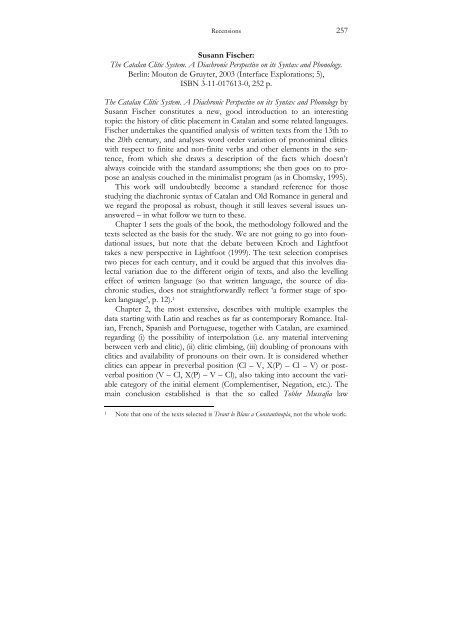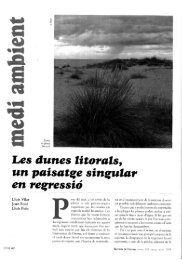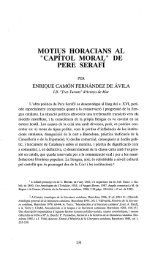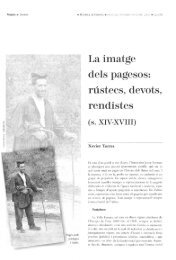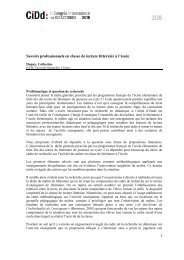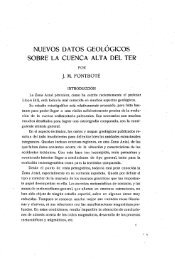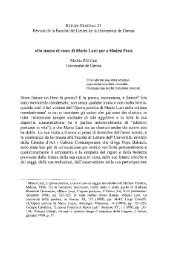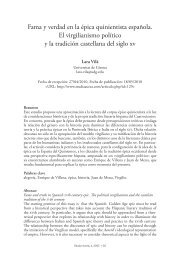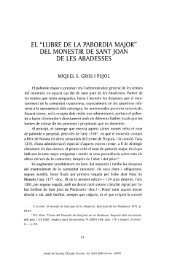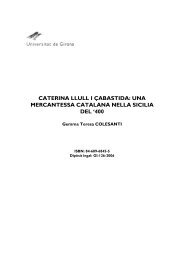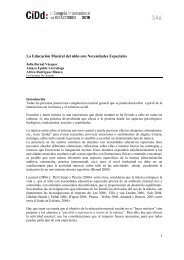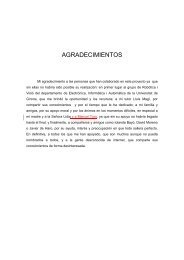257 Susann Fischer: The Catalan Clitic System. A Diachronic ...
257 Susann Fischer: The Catalan Clitic System. A Diachronic ...
257 Susann Fischer: The Catalan Clitic System. A Diachronic ...
You also want an ePaper? Increase the reach of your titles
YUMPU automatically turns print PDFs into web optimized ePapers that Google loves.
Recensions <strong>257</strong><br />
<strong>Susann</strong> <strong>Fischer</strong>:<br />
<strong>The</strong> <strong>Catalan</strong> <strong>Clitic</strong> <strong>System</strong>. A <strong>Diachronic</strong> Perspective on its Syntax and Phonology.<br />
Berlin: Mouton de Gruyter, 2003 (Interface Explorations; 5),<br />
ISBN 3-11-017613-0, 252 p.<br />
<strong>The</strong> <strong>Catalan</strong> <strong>Clitic</strong> <strong>System</strong>. A <strong>Diachronic</strong> Perspective on its Syntax and Phonology by<br />
<strong>Susann</strong> <strong>Fischer</strong> constitutes a new, good introduction to an interesting<br />
topic: the history of clitic placement in <strong>Catalan</strong> and some related languages.<br />
<strong>Fischer</strong> undertakes the quantified analysis of written texts from the 13th to<br />
the 20th century, and analyses word order variation of pronominal clitics<br />
with respect to finite and non-finite verbs and other elements in the sentence,<br />
from which she draws a description of the facts which doesn’t<br />
always coincide with the standard assumptions; she then goes on to propose<br />
an analysis couched in the minimalist program (as in Chomsky, 1995).<br />
This work will undoubtedly become a standard reference for those<br />
studying the diachronic syntax of <strong>Catalan</strong> and Old Romance in general and<br />
we regard the proposal as robust, though it still leaves several issues unanswered<br />
– in what follow we turn to these.<br />
Chapter 1 sets the goals of the book, the methodology followed and the<br />
texts selected as the basis for the study. We are not going to go into foundational<br />
issues, but note that the debate between Kroch and Lightfoot<br />
takes a new perspective in Lightfoot (1999). <strong>The</strong> text selection comprises<br />
two pieces for each century, and it could be argued that this involves dialectal<br />
variation due to the different origin of texts, and also the levelling<br />
effect of written language (so that written language, the source of diachronic<br />
studies, does not straightforwardly reflect ‘a former stage of spoken<br />
language’, p. 12). 1<br />
Chapter 2, the most extensive, describes with multiple examples the<br />
data starting with Latin and reaches as far as contemporary Romance. Italian,<br />
French, Spanish and Portuguese, together with <strong>Catalan</strong>, are examined<br />
regarding (i) the possibility of interpolation (i.e. any material intervening<br />
between verb and clitic), (ii) clitic climbing, (iii) doubling of pronouns with<br />
clitics and availability of pronouns on their own. It is considered whether<br />
clitics can appear in preverbal position (Cl – V, X(P) – Cl – V) or postverbal<br />
position (V – Cl, X(P) – V – Cl), also taking into account the variable<br />
category of the initial element (Complementiser, Negation, etc.). <strong>The</strong><br />
main conclusion established is that the so called Tobler Mussafia law<br />
1 Note that one of the texts selected is Tirant lo Blanc a Constantinopla, not the whole work.
258 Buchbesprechungen<br />
according to which clitics must appear in 2nd position cannot be maintained.<br />
Yet, <strong>Fischer</strong>’s example (74) [(1) here] arguably is not a counterexample<br />
to the Tobler Mussafia law; since according to successive works by<br />
Lema and Rivero topicalised elements such as those in (74) should be<br />
regarded as outside the range of the Tobler Mussafia effect, which applies<br />
within CP (see Lema / Rivero, 1991; Lema, 1994).<br />
(1) … e io fer-li he tota aquella honor que hem serà possible,<br />
‘and I will give him all the honor that will be possible for me,’<br />
(74) in <strong>Fischer</strong>, 2002: 50<br />
Second, following the author, that clitics appear both pre- and postverbally<br />
in finite clauses holds true of a longer period than usually thought: contemporary<br />
<strong>Catalan</strong> only allows preverbal clitics with finite verbs, but postverbal<br />
clitics were still attested in the 19th century. Interestingly, postverbal<br />
clitics with finite verbs are found in contemporary Romance in Portuguese<br />
(as expressed on p. 94), but also in Asturian and Leonese varieties, which<br />
allow them pre- and postverbally: It would be relevant to find out if the<br />
meaning contrast between sentences with different clitic/verb positions<br />
holds in these varieties as claimed by <strong>Fischer</strong> for Old <strong>Catalan</strong>.<br />
(2) Tol mundu lo dicía. Gustábame munchu tener un rapazu en cuello<br />
(…)<br />
‘Everybody said so. I liked very much having a child in my arms’<br />
Cuándu lu traen…? Y dexarésme traelu en cuello?<br />
‘When are they bringing him? And will you let me have him in my<br />
arms?’ (Asturian: El duviellu by M. Josefa Canellada)<br />
Chapters 3 and 4 review former research on the diachronic syntax of<br />
Romance. <strong>The</strong> predictions of the hypotheses presented are not always sufficiently<br />
explicit for the non-specialised reader and on occasion do not<br />
seem to be made full justice (as for example with Halpern, 1995, which, as<br />
far as we understand, makes no predictions as to clitics in medial position,<br />
except that they must have a host to their left). An argument held against<br />
prosodic accounts is that on occasion the clitic is postverbal when there is<br />
another element in initial position, seemingly precluding enclisis to the<br />
verb; yet, the first element could be topicalised, in which case enclisis to<br />
that first element would not be feasible – such a possibility could be<br />
entertained.
Recensions 259<br />
Particular analyses are dismissed, such as Martineau’s (1991) treatment<br />
of clitic climbing in Old French, but no alternative proposal is made to<br />
encompass Old French and <strong>Catalan</strong>. It should also be pointed out that,<br />
contrary to <strong>Fischer</strong>’s stances, Old <strong>Catalan</strong> presented sentences without<br />
clitic climbing, such as (3):<br />
(3) e no m cal dar-hi fe. (March, Poema 20.7)<br />
<strong>The</strong> empirical coverage could also be improved on: regarding the author’s<br />
assertion (p. 62) that no examples are available for split futures in the 16th<br />
century, Keniston (1937: 438–439) provides three examples from the Dialogo<br />
de la lengua of Juan de Valdés together with some more. <strong>Clitic</strong> placement<br />
in 19th century Romance has been the object of González Ollé<br />
(1983), as well as Rini (1990) and Martins (1995) mentioned by <strong>Fischer</strong>.<br />
Chapters 5 and 6 comprise <strong>Fischer</strong>’s original analysis, according to<br />
which clitic placement follows from verb movement to a functional projection<br />
Σ(P). <strong>Clitic</strong>s are postverbal when V raises to Σ due to an uninterpretable<br />
feature in Σ, and clitics are preverbal when V remains below ΣP,<br />
in TP: this happens when Σ is occupied by a lexical element such as negation<br />
– hence the desirable prediction that the order (XP) – Neg – Cl – V is<br />
the only possible one while (XP) – Neg – V – Cl is unattested.<br />
(4) Fèlix demanà al ermità hon és Déus, car fort se meravellava com no.l<br />
veya.<br />
‘Fèlix asked the hermit where God was, because he wondered that he<br />
didn’t see him.’ (Ramon Llull, Llibre de Meravelles, 66,10)<br />
In terms of motivation, what is not clear is why at a certain point, in the<br />
14th–15th century, verb raising should have disappeared in embedded<br />
clauses (the semantic reason adduced would seem to preclude verb raising<br />
in embedded clauses generally). <strong>The</strong> feature specification of Σ in Old<br />
<strong>Catalan</strong> is assumed without independent empirical evidence to support it.<br />
Having said this, the basic idea of clitic placement as dependent on V raising,<br />
and economy principles driving the diachronic process is a simple and<br />
elegant solution and fits in with work in other, perhaps related, areas such<br />
as acquisition (see Zuckerman, 2001, and Gavarró, 2003, on English and<br />
<strong>Catalan</strong>).<br />
With respect to the phonological aspects, <strong>Fischer</strong> points out the regularity<br />
of the clitic forms (p. 185); however, it is confusing that this should
260 Buchbesprechungen<br />
be termed allomorphy if the pattern can be attributed to vowel insertion (a<br />
regular phonological process, rather than a morphological idiosyncrasy), as<br />
already established by Wheeler (1979). What’s more, the shape the clitic<br />
takes varies across dialects (the description of modern dialects on page 71<br />
with e.g. em as proclitic and me as enclitic is only valid for some dialects; in<br />
other varieties me is still proclitic). Much of what is assumed to hold for<br />
modern <strong>Catalan</strong> (on the basis of Central <strong>Catalan</strong> texts) holds only for a<br />
subset of <strong>Catalan</strong> varieties. This is of no consequence for the conclusions<br />
reached by the author, but needs qualification. Note also that clitic climbing<br />
is obligatory in contemporary Balearic varieties, so optionality is not as<br />
pervasive as asserted. Orthographic issues also seem to confuse matters, as<br />
when the locative clitic hi and its orthographic variants are discussed (p. 32,<br />
65; confusion finally dispelled in footnote 21 of chapter 5).<br />
In the end the reader is left with the wish for a comprehensive account<br />
of the phenomena described in the earlier chapters of the book: why interpolation<br />
is possible in other Romance varieties but not in <strong>Catalan</strong> (as<br />
already noted in Ramsden, 1963); why doubling emerges in Romance;<br />
when interpolation is possible in Romance (see the account of Martins, in<br />
press, which regards all Old Romance clitics as heads, not only the <strong>Catalan</strong><br />
ones, and attributes interpolation to factors other than the head character<br />
of the clitic). We hope that <strong>Fischer</strong> will pursue these issues with the same<br />
thrust as she has shown in her thesis. We would also wish for a revised<br />
version of the present work, including some more editorial accuracy, even<br />
more necessary when this book is due to become a standard reference in<br />
the field.<br />
References<br />
Chomsky, N. (1995): <strong>The</strong> Minimalist Program, Cambridge, Mass.: MIT Press.<br />
Gavarró, A. (2003): “Economy and word order patterns in bilingual English–Dutch<br />
acquisition”, Bilingualism: Language and Cognition 6:1, 69–79.<br />
González Ollé, F. (1983): “Enclisis pronominal en el participio de las perífrasis<br />
verbales”, Revista de Filología Española LXIII:1–2, 1–32.<br />
Halpern, A. (1995): On the Placement and Morphology of <strong>Clitic</strong>s, Stanford: CSLI<br />
Publications.<br />
Keniston, H. (1937): <strong>The</strong> Syntax of Castilian Prose. <strong>The</strong> Sixteenth Century, Chicago:<br />
<strong>The</strong> University of Chicago Press.
Recensions 261<br />
Lema, J. (1994): “Los futuros medievales: sincronía y diacronía”; in: Demonte,<br />
V. (ed.): Gramática del español, México D.F.: Colegio de México.<br />
— / Rivero, M. L. (1991): “Types of verbal movement in Old Spanish:<br />
modals, futures and perfects”, Probus 3:3, 1–43.<br />
Lightfoot, D. (1999): <strong>The</strong> Development of Language: Acquisition, Change and<br />
Evolution, Oxford: Blackwell.<br />
Martineau, F. (1991): “<strong>Clitic</strong> climbing in infinitival constructions of Middle<br />
French”, in: Wanner, D. / Kibbee, D. A. (eds.): New Analyses in Romance<br />
Linguistics, Amsterdam: John Benjamins, 235–251.<br />
Martins, A. M. (1995): “<strong>Clitic</strong> placement from Old to Modern European<br />
Portuguese”, in: Andersen, H. (ed.): Historical Linguistics 1993, Amsterdam:<br />
John Benjamins, 295–302.<br />
— (in press): “<strong>Clitic</strong> placement, VP-ellipsis and scrambling in Romance”,<br />
in: Batllori, M. et al. (eds.): Grammaticalization and Parametric<br />
Change, Oxford: Oxford University Press.<br />
Ramsden, H. (1963): Weak-pronoun Position in the Early Romance Languages,<br />
Manchester: Manchester University Press.<br />
Rini, J. (1990): “Dating the grammaticalisation of the Spanish clitic pronoun”,<br />
Zeitschrift für Romanische Philologie 106, 354–370.<br />
Wheeler, M. (1979): Phonology of <strong>Catalan</strong>, Oxford: Blackwell.<br />
Zuckerman, S. (2001): <strong>The</strong> Acquisition of Optional Movement, Groningen:<br />
Groningen Dissertations in Linguistics 34.<br />
Montserrat Batllori (Girona)<br />
Anna Gavarró (Barcelona)<br />
Francesc Ruiz i San Pascual, Rosa Sanz i Ribelles,<br />
Jordi Solé i Camardons:<br />
Diccionari de Sociolingüística<br />
Barcelona: Enciclopèdia <strong>Catalan</strong>a, 2001, ISBN 84-412-0733-X, 328 S.<br />
Das katalanische Diccionari de Sociolingüística, 2001 im Verlag Enciclopèdia<br />
<strong>Catalan</strong>a erschienen, enthält 1150 Einträge zu Konzepten und Begrifflichkeiten<br />
aus verschiedenen kontextuellen Disziplinen, welche als gemeinsame<br />
Achse die Soziolinguistik haben. Hierzu zählen neben den linguisti-


